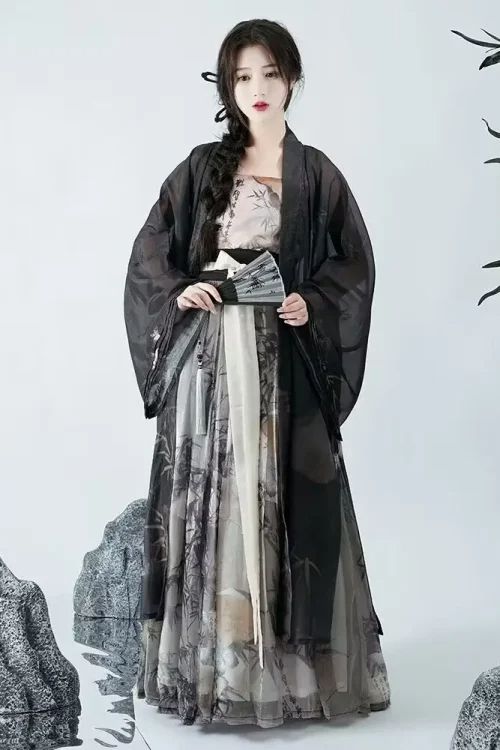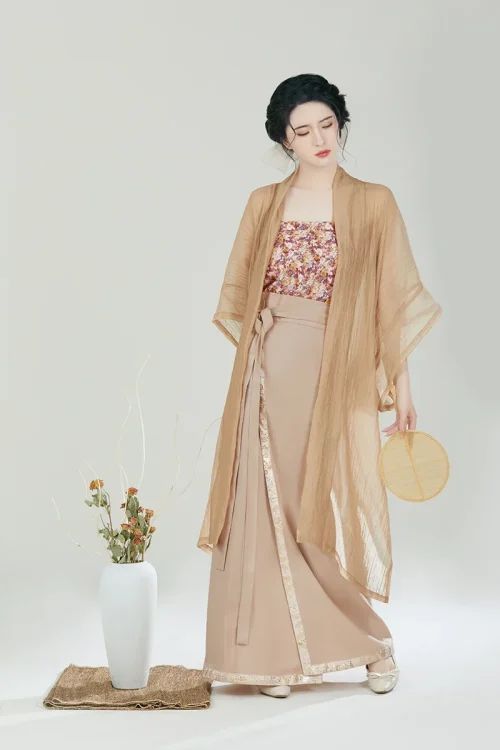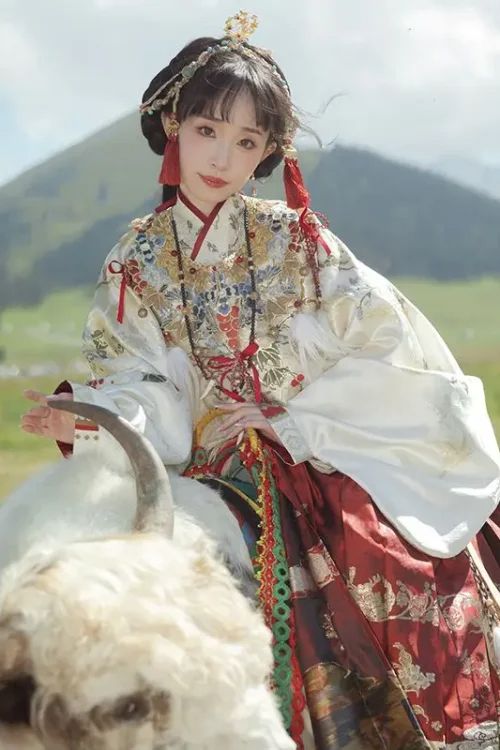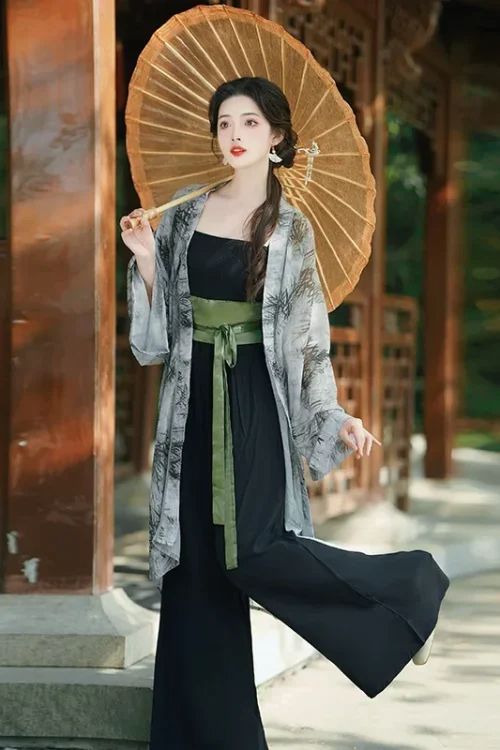The Flowing Grace of Water: Exploring the Fluid Movement Captured in 汉服 Wave Patterns
Introduction
The flowing grace of water has long been a source of inspiration for artists and designers, and its influence can be seen in a wide variety of art forms, from painting and sculpture to fashion and architecture. In the realm of fashion, the water wave pattern is a particularly popular motif, and it can be found on everything from traditional Chinese Hanfu to modern swimwear.

The Water Wave Pattern in Hanfu
The water wave pattern is often associated with femininity and grace, and it is often used to create a sense of movement and fluidity in a garment. The pattern can be created using a variety of techniques, including dyeing, printing, and embroidery, and it can be used to create a variety of different effects.
Traditional Hanfu Applications
In traditional Chinese hanfu, the water wave pattern is often used to create a sense of elegance and refinement. The pattern is typically created using a subtle dyeing technique, and it is often combined with other auspicious symbols, such as dragons and phoenixes. The water wave pattern is also often used in the design of hanfu sleeves, where it can create a sense of movement and grace when the wearer moves.
现代 Fashion Interpretations
In modern fashion, the water wave pattern is often used to create a more playful and youthful look. The pattern can be created using a variety of bright and bold colors, and it is often used on swimwear, dresses, and skirts. The water wave pattern can also be used to create a sense of texture and dimension in a garment, and it can be used to add a touch of glamour to any outfit.

结论
Whether it is used in traditional Chinese hanfu or modern fashion, the water wave pattern is a versatile and beautiful motif that can be used to create a variety of different effects. The pattern is associated with femininity, grace, and movement, and it can be used to add a touch of elegance and sophistication to any garment.
The Rhythm of Nature: Uncovering the Harmonic Patterns of Water Waves in Hanfu Designs
Introduction
The water wave pattern, a ubiquitous motif in Hanfu designs, draws inspiration from the rhythmic undulations of water. This pattern embodies the fluidity and grace of nature, offering a glimpse into the ancient Chinese philosophy of harmony with the environment.

Symbolism of Water Waves
The water wave pattern symbolizes the cyclical nature of life, mirroring the ebb and flow of the tides. Its gentle curves evoke a sense of tranquility and serenity, reminding us of the interconnectedness of all things. By incorporating this pattern into their garments, Hanfu wearers express their reverence for the natural world and their desire to live in harmony with it.
Transformative Power
Moreover, the water wave pattern represents the transformative power of water. Just as water can cleanse and purify, the pattern symbolizes the ability to shed negative energies and embrace new beginnings. It is often associated with prosperity and abundance, as water is essential for life and growth.
Yin and Yang Balance
The water wave pattern also reflects the Chinese concept of yin and yang. The alternating curves represent the interplay of opposing forces, such as light and dark, male and female, and heaven and earth. This balance is essential for harmony and well-being, and the water wave pattern serves as a reminder to strive for equilibrium in all aspects of life.
Aesthetic Appeal
In addition to its symbolic significance, the water wave pattern is also aesthetically pleasing. Its flowing lines create a sense of movement and dynamism, adding a touch of elegance and sophistication to Hanfu garments. The pattern can be rendered in various colors and fabrics, allowing for endless possibilities of expression.
结论
The water wave pattern on Hanfu is not merely a decorative element; it is a profound symbol that embodies the ancient Chinese philosophy of harmony with nature. It represents the cyclical nature of life, the transformative power of water, the balance of yin and yang, and the pursuit of aesthetic beauty. By wearing Hanfu adorned with this pattern, individuals connect with the natural world and express their appreciation for the rhythms and patterns that govern our existence.
The Symbolism of Water: Interpreting the Cultural Significance of Wave Patterns in Hanfu
Introduction
The water wave pattern, a ubiquitous motif in Hanfu, the traditional clothing of the Han Chinese, holds profound cultural significance. Its origins can be traced back to ancient Chinese mythology, where water was revered as a life-giving force and a symbol of purity and renewal.

Cultural Associations
The wave pattern, often depicted as undulating lines or stylized waves, evokes the fluidity and dynamism of water. It represents the cyclical nature of life, the ebb and flow of time, and the constant transformation of the world around us. In Hanfu, the water wave pattern is often paired with other auspicious symbols, such as dragons, clouds, and mountains, to create a harmonious and balanced composition.
Relationship with Water
Beyond its mythological associations, the water wave pattern also reflects the close relationship between the Han Chinese and water. China is a land of rivers and lakes, and water has played a vital role in its history and culture. The water wave pattern in Hanfu serves as a reminder of the importance of water for irrigation, transportation, and sustenance.
Yin and Yang Concept
Furthermore, the water wave pattern embodies the Chinese concept of yin and yang. The undulating lines represent the interplay between opposing forces, such as light and dark, male and female, and heaven and earth. This balance is essential for harmony and well-being in both the natural world and human society.
Contemporary Inspiration
In contemporary times, the water wave pattern continues to inspire designers and artists. Its timeless beauty and cultural significance make it a popular motif in fashion, home décor, and other creative endeavors. By incorporating the water wave pattern into their designs, contemporary creators pay homage to the rich cultural heritage of China while also expressing their own unique perspectives.
结论
In conclusion, the water wave pattern on Hanfu is a multifaceted symbol that draws upon ancient mythology, cultural beliefs, and the close relationship between the Han Chinese and water. It represents the cyclical nature of life, the importance of balance, and the enduring legacy of Chinese culture. As a timeless motif, the water wave pattern continues to inspire and resonate with people today, serving as a bridge between the past and the present.
